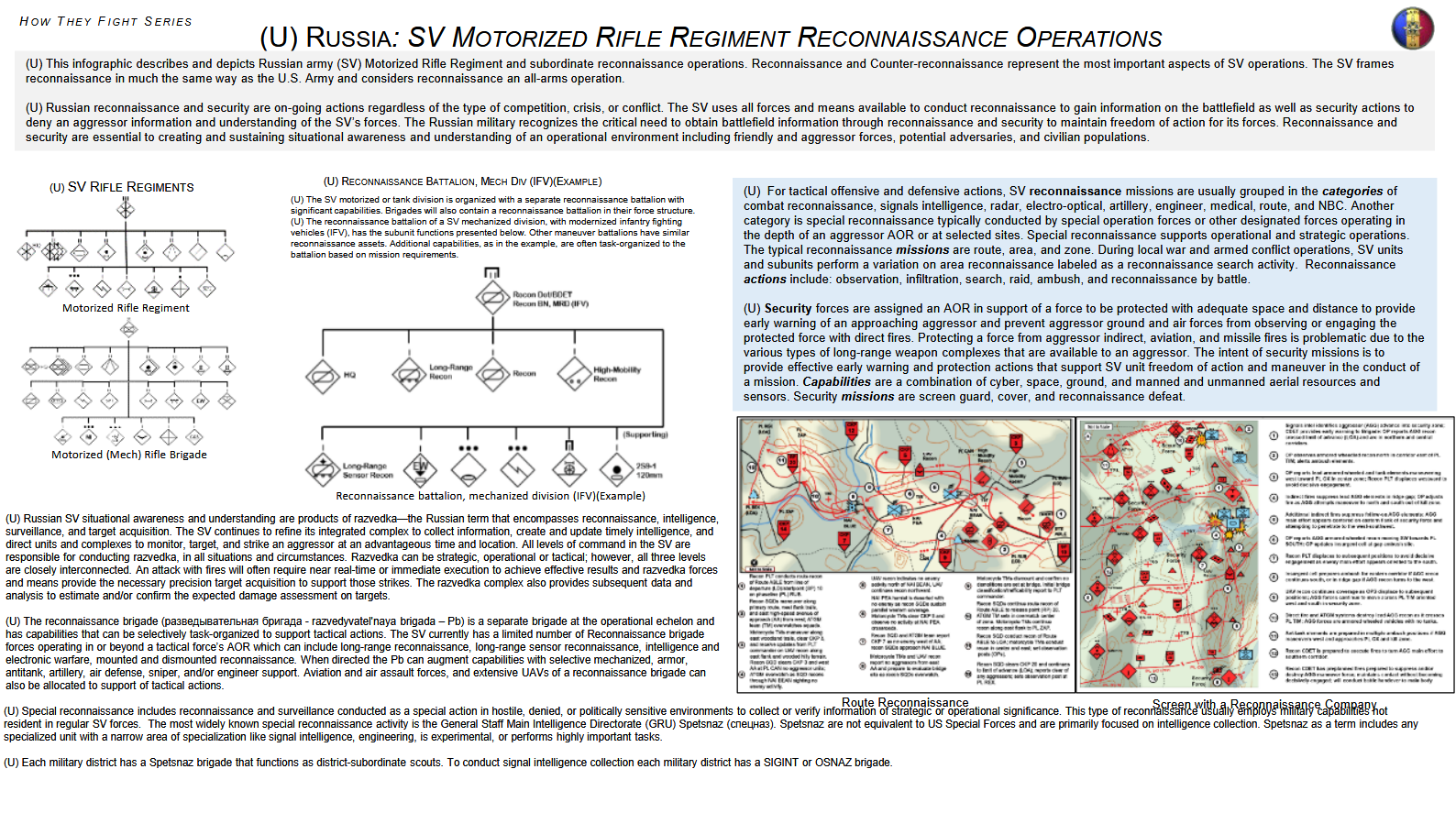
Russia
Russian Troops enter Dnipropetrovsk
**
Russian Troops enter Dnipropetrovsk **
The Worldwide Equipment Guide (WEG) is a tool to support U.S. Army training and Opposing Force (OPFOR) (constructive, virtual, live, and gaming). The equipment portrayed in the WEG represents military systems, variants, and upgrades that U.S. forces may encounter now and in the foreseeable future.
Threat Minutes are a series of TRADOC G2-produced short-form videos that introduce foundational information and concepts about the Threat and the Doctrinal Opposing Force as a low-barrier entry point to more comprehensive G2 products. This playlist focuses on foundational information on Russia's ground forces - the SV.
Russian Military Today (Mid-2025)
1. Strategic Posture & Spending
Wartime economy footing: Russia’s defense spending remains extremely high—at 6.3% of GDP according to some estimates Russia Matters. Even once adjusted, analysts suggest its military procurement capacity rivals Europe’s Defense News.
2. Force Generation & Mobilization
Personnel expansion & structural changes: Russia is expanding its armed forces—aiming for up to 1.5 million personnel, and forming new divisions, brigades, and combined-arms armies Russia MattersAtlantic Council.
Unmanned Systems Forces (USF): A new, standalone branch focused on drones (air, ground, naval) is being created. The campaign began in late 2024, with initial regiments formed in early 2025. It's targeting up to 210,000 personnel by 2030.
3. Industrial & Technological Adaptation
Production surges: Russia has ramped up outputs—delivering thousands of armored vehicles, aircraft, drones, and EW systems in 2024 alone Russia MattersWikipedia. Civilians now produce up to 40,000 drones per month Wikipedia.
Missile and EW production: Reports indicate missile production could reach 1,000 per year, resumption of bombers like Tu-95, and modernization of strategic bombers (Tu-160, Tu-22M) Institute for the Study of War Russia Matters.
Foreign collaboration & exports: Rosoboron export is deepening joint production deals globally, worth tens of billions, while state actors push for increased small-tech firms and VAT relief for drone components to fuel domestic drone proliferation.
4. Hybrid & Cyber Warfare
Advanced EW and hybrid operations: Russia employs potent electronic warfare tools (e.g., Tirada-2) that degrade NATO systems, combined with a strong hybrid campaign across Europe using sabotage, cyberattacks, and disinformation https://debuglies.comWikipedia.
AI & autonomous capabilities: The military emphasizes AI-enabled drone swarms, autonomous combat modules, and plans for robotic force that could contribute 30% of combat power by 2030 Wikipedia.
5. Nuclear & Strategic Forces
Largest nuclear arsenal: Russia possesses the world’s biggest nuclear stockpile—estimated at over 5,400 warheads in 2025, including strategic subs and bombers.
This 2025 update on Russia includes a geo-political perspective with a strategic to operational overview of their military and what’s new in terms of strategy and approach. My sources include the US DNI Annual Threat Assessment, released a couple of months ago and the DC based think tank – the Center for European Policy Analysis or CEPA’s recent paper titled “Russia’s Strategy and Military Thinking: Evolving Discourse by 2025”. Also, the US Army’s ATP 7-100.1. Much of the content follows the US military operational environment framework of PMESII-PT in order to fully capture the Russian operational environment in 2025.
Russia launched the Oreshnik IRBM at the Ukrainian city of Dnipro, this Intermediate Range Ballistic Missile (IRBM) marks the first use of a hypersonic ballistic missile with MIRV warheads and a nuclear payload capability in a direct combat engagement. The Oreshnik is an experimental IRBM based on Russia’s RS-26 Rubezh ICBM, the Oreshnik has a reported range of 3,410 miles, giving it access to most of Europe.
Russia continually seeks to develop technologies that increase capabilities that achieve overmatch using both developments from the civilian sector as well as direct military advances. This discussion focuses on currently employed Russian EM capabilities as well as the force structure that supports the deployment of EM capabilities. Russian Electromagnetic Battle (REB) is discussed along with it's four functional areas: 1) Electromagnetic Attack, 2) Electromagnetic Protection, 3) Comprehensive Technical Control, 4) Radio-electromagnetic information support measures.
Russian forces are are now employing the tactic of "envelopment" more and more in Ukraine successfully and have used this tactic for centuries. To be clear, it’s not a Russian tactic, Alexander the great used it successfully against the Persians in the Battle of Guagamela. Most notably, the Soviet Union used this tactic against the invading German forces in the battle of Stalingrad. When conducting a tactical, operational mission or strategic campaign it is important to emphasize the importance of knowing the basic tenets of military operational design that have been employed throughout ancient and modern military history.
Russians execute attritional warfare, they play the long game and that’s what we seem to be seeing in the War in Ukraine. There are countless historical examples of this Russian military ideology, even Napoleon commented on the Russian military mindset, that they have “European discipline with Asian tyranny”, that quote is more than 200 years old but it still applies. Unfortunately, Russia seems to be capable of absorbing the losses it is seeing, I hope that Ukraine can keep pace, but I am concerned for Ukraine as we approach the third year of this horrific War.
As Ukraine (with the support of the collective West) contemplates ballistic missiles strikes deep inside Russia, it's important to understand Russian IADS using the snow dome as a framework to understand the principal capabilities of the Russian layered defense network.












